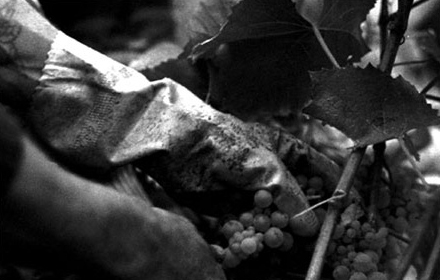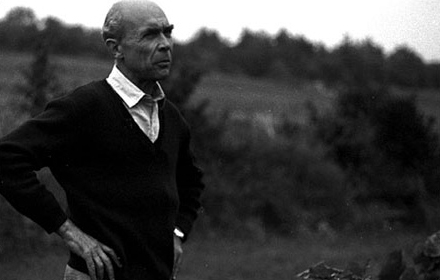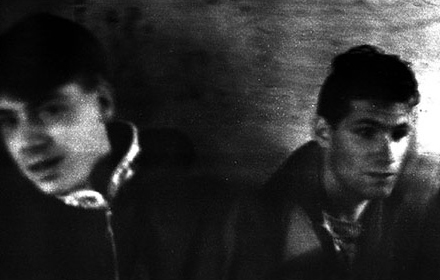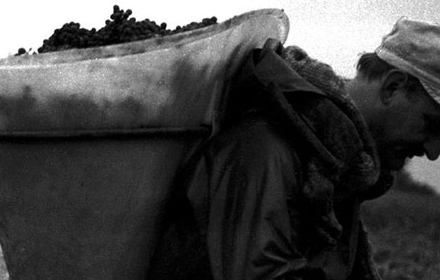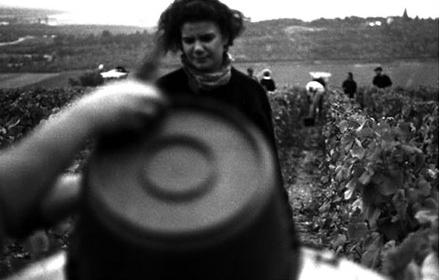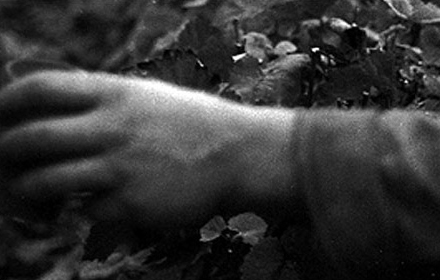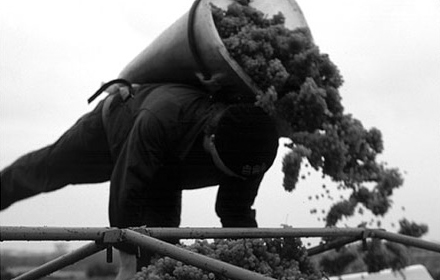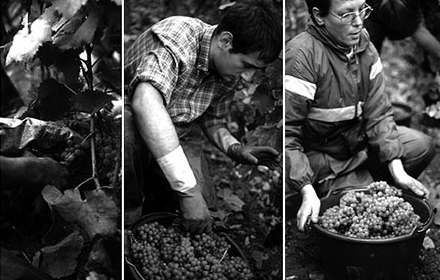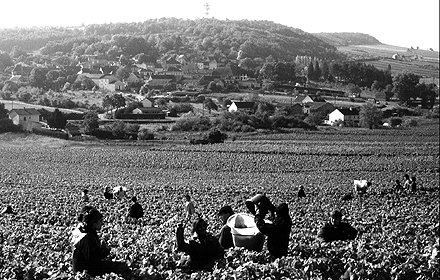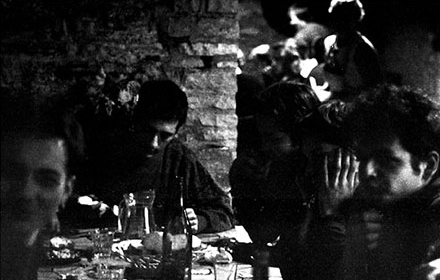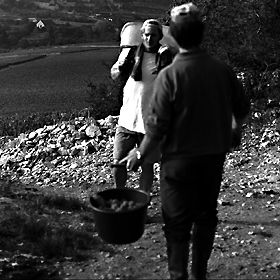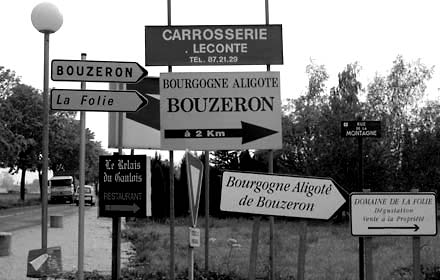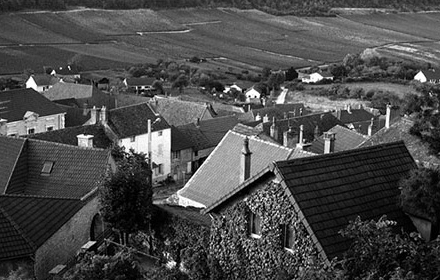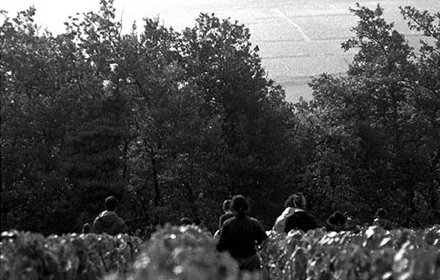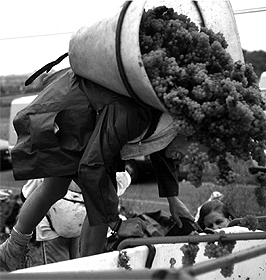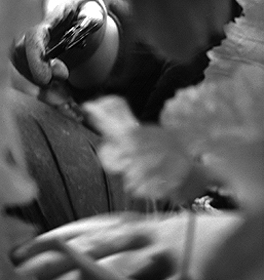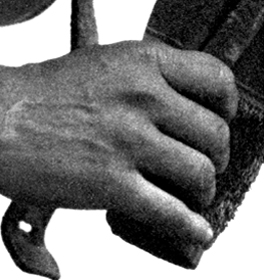|
|
|
| A photo diary: the passing days of a grape
harvest in rural France. These photos chronicle 12 days of harvest
at the vineyards of Aubert & Pamela de Villaine in the village
of Bouzeron in the Côte Chalonnaise. The harvest usually
begins in late September, the date coming more or less one hundred
days after the flowering of the vines in the early summer. |
|
| For the harvester, the workday begins at 7:45am
and ends around 6:00pm. The days are spent working in teams
up rows of vines one plot after the next. The mornings are cold
and the afternoons are often warm. In the trucks that carry
the workers to the vines lies a pile discarded sweaters and
coats. |
|
| The anticipation of the lunch break and dinner
is fueled by occasional bottles of the wine and water passing
between the vines. Before lunch, we wash the mud from our clothes
with a garden hose. Lunch invariably includes a meat stew, wine,
cheese and fruit. Conditions when the foreman is most eager
to get back to work: impending storms, late starts, troubles
with the tractors. |
|
| It matters to have good rubber gloves, good
clippers and interesting co-workers. Although each day is long,
one falls into the next. In a routine of working between the
vines buried in one's thoughts, rising up to see the wide vistas,
stopping for conversations, water or wine, or sharing songs
and words between the grape leaves, the fortnight can begin
to seem like a single long day. The day is punctuated by highs
and lows, shifting moods, and changing weather. |
|
At the moment he announces the harvest,the
winemaker is gambling with nature. Bring forty harvesters to
your property too early, you pay for them to sit about; if they
come too late, you might lose the harvest to rain or hail. The
problem is complicated by growing three different varieties
– Chardonnay, Pinot Noir, and Aligoté – which
ripen at different times. Hail in the next village is ominous:
for winemakers just over the crest of the hill, the hail has
caused the loss of a year's work.
|
|
| Although the Aligoté is the most important
grape in this vineyard, it ripens slightly later than the other
varieties that are growing. First to come in is the Chardonnay,
then the Pinot Noir. The order of cutting is a question of ripeness,
value and practicalities. The grapes cannot all be cut in one
day. |
|
| In cutting the reds, one must watch carefully
to spot ripeness and rot. A sour taste will tell, but it will
also pucker the mouth. One looks for the light pink or green
showing through the skins. |
|
|
| Gloves wear through quickly. Without them,
the sugary moistness of the grapes helps to bring on blisters.
The gloves, clippers, and grapes become intimate objects –
extensions of the flesh. |
|
| With tough, tannin-rich skins, the grapes
taste a little bitter. To make a good wine they must offer a
balance of acids and fruit sugars. The aromas and flavors of
the wine to be made exisit now only as potential. In harvest,
it matters that the grapes arrive at the winery undamaged and
as soon as possible after they are cut. |
|
| The grapes pass from the vines to buckets,
from the buckets to panniers, from the panniers to tractors,
from the tractors to the winery. How much care the grapes receive
at each stage is mediated by cost. The choices are determined
by the market value of the wine that the grapes of a particular terroir can produce. |
|
Tasks are assigned and repetitive. The pickers
select the grapes: Red grapes should not be cut too green,
or with too much leaf. Rotten grapes should be cut away. At
the tractor, the foreman eyes the quality of the grapes. The
porter who has carried the grapes to the tractor may return
to the harvesters in his team with instructions or admonitions. |
|
| Best are the tiny concentrated grapes of older
vines whose roots reach far into the bedrock where they extract
richer mineral content. Vines become worth harvesting after
about four years and can produce good yields for fifty or sixty
years – a human's lifetime. The unique quality of time
felt during the harvest is set against the long history of the
vines and the culture supporting them – vines are planted
for lifetimes and across generations. |
|
| We, too, come from various generations. There
are mothers and their daughters, cousins, immigrants, returning
workers, local friends, and students. A number of local factory
workers, once connected to the vineyard, join the harvest for
the festive first day. A couple from Poland who met here at
a harvest over a decade ago when the money mattered more, now
come each year for a working holiday. |
|
| At the dining table there is
a kind of weary revelry. In work, there is little time to stop
or reflect on the action at hand. The dining tables are in a
cavernous room beneath the house and dormitories. The room is
dark and comforting to eyes that have come in from hours in
the sun. The space is damp and has a rich smell of the meat
stews we are served. |
|
|
| The soft, thick and crumbling stone walls
fall into darkness illuminated only by the small beams of light
that come from the door and small deep windows. In the vines
we begin thinking of lunch ahead. In the dining hall, there
is a desire to remain suspended between the memory and anticipation
of the work outside. |
|
| Visually, when one is working in the vines,
the world seems either very near or very distant; it is a world
of close-ups and landscape vistas. The presence of the fellow
workers comes by way of the sounds and conversations which pass
through the thicket. You feel your body in parts: your hands,
your knees, or your back, and you catch the occasional glimpse
of other workers in fragments through the leaves, posts, and
wires. |
|
|
...THIS IS THE END OF THE SAMPLE ... BUT THE HARVEST CONTINUES.. |
Please visit www.eastgate.com to see the full work...
|
. |
|
|
 |
 |
 |
Recognitions are a photo's proposition: a sense of peace in the vines,
the urgency of a boss, the forms of faces in changing light, the halting
of time as the harvesters rest and regard the view at the end of a row
of vines. Movements
are arrested, their narrative directions are like vectors – the stories
are not yet determined. Against the (e)motion of stillness and the seeming
timelessness of lunch hours in the winery caverns, I recall the immediacy
of carrying a pannier full of grapes and the pressuring shouts of Jean-Louis,
the harvest foreman.
|
| Shuffling these photo documents into
differing orders, I find myself reinventing a series of pasts in the
hindsight of narrative. Organizing the photos in a row reminds me
of comic strips, of the slide strips of old viewing machines, of film
storyboards, and of dream recollections where the conjunctions between
images have slipped from memory. Jumping back and forth, patterns
emerge of alternative stories. |
The
focus shifts to the space between the people and the landscape
views – to the enveloping world of vines, grapes, posts and soils.
Angles by which I viewed people resemble others I took of objects. |
|
The histories of people differ from those of images
which direct the eye to see continuities and contrasts. Such pictures
describe relationships between one person and another or between people,
the objects they use, and spaces they occupy. END OF SAMPLE.... WORK CONTINUES... |
 |
 |
 |
|
In the vines one day, Aubert de Villaine tells me that
for him, "Wine is an image," by which he means,
as he goes on to say, that each aspect of winemaking is
part of a process of working toward an ideal form.
The image, he tells me, is "based on the wines that
he has known in the past." His goal is to make wine
in ‘the simplest ways possible’ to yield a product
that is pure. |
|
|
This "image" of the wine is a reflection of Aubert's
taste, memory and knowledge of what different soils, grapes
and conditions might provide.It is a reflection of cultural
ideals he holds about balance, structure and elegance. As other
winemakers would repeatedly tell me, a wine is a reflection
of the character of the maker who has envisioned and produced
it. |
|
Aubert and Pamela moved to Bouzeron in 1970. Although winemaking
was introduced to this valley by the church in the middle ages,
the vines had been since abandonned. When Aubert and Pamela
arrived there was little winemaking here. However, through research
in the archives at Macon and elsewhere, Aubert discovered that
the valley had a history of winemaking and was once particularly
known for the white Aligoté. |
|
|
Following the deadly outbreak of phylloxera, a pest native to
North America that destroyed most of the French vineyards at
the end of the nineteenth century, the area around Bouzeron
was, for the most part, not replanted. This was probably because
the land here is less suited to the more popular Chardonnay
and Pinot Noir vines that were being planted in other areas
to the north on the Côte d'Or, some of which had also
been previously recognized for their Aligoté production. |
|
The classification of the terroir and its wines is achieved
through a system of ranking known as the Appellation d’Origine
Contrôlée (AOC). The ranks include regional wine
designations such as "Bourgogne Aligoté," village
specific appellations, premiere growths, and grand cru. These
rankings, developed in the 1930s, are based on expectations
of what differing terroirs can produce. |
|
Even the greatest Aligoté is a modest wine when compared
to the famous grand cru Chardonnays and Pinot Noirs of the Côte
d'Or. Aubert's vision of his wine is based on what he believes
a terroir can yield. His role is to assist in a natural process.
This includes moderating negative forces, such as those of frost
and mildew, which can diminish the health of the vine and the
positive qualities of grapes. The vision is also based on how
he envisions the work and the world he builds for himself. To
make wine, Aubert
once remarked, you always stand before a white sheet, not
knowing what nature has in store for you. In this way you are
both the maker and marionette. |
|
|
The AOC sets requirements such as varietal percentages and minimum
sugar levels such that a wine grown on grand cru soils might
not obtain its grand cru status on a particularly poor year.
At Bouzeron, Aubert worked with the other winemakers to gain
AOC village status, the only such status in France for the Aligoté.
Around the village of Bouzeron the soil is particularly poor.
De Villaine believes this helps intensify the flavors of the
Aligoté which is a vigorous vine. At the same time the
conditions are more challenging than the Côte d’Ort;
an ideal image of a wine co-exists with that determined by temporal,
economic, or even cultural circumstances. |
|
Aubert arrived in Bouzeron with extensive experience in the
issues of making grand cru wine. He followed his father as a
co-owner/winemaker at the famous Domaine de la Romanée
Conti in Vosne-Romanée where he continues to make grand
cru Pinot Noir and Chardonnay. Making a wine in the less established
valley of Bouzeron presents a different set of challenges, such
as a more frequent risk of frost, and less options in solving
problems because the price that local wine can fetch will not
support the use of expensive technologies. |
|
Aubert sees himself as participating in a long history of winemaking.
He reads logs from past winemakers to learn about prior knowledge
of the terroir and climate conditions and he writes notes of
his own experiences over time. Along with developing the Bouzeron
Aligoté, Aubert has been a force in promoting a regional
identity for this area south of the prestigious Côte d’Or
under the name of the Côte Chalonnaise. Its vineyards
stretch across the hills above the Soâne between Chagny
and Chalon-sur-Soâne to include towns such as Givry, Mercurey,
and Rully. |
|
... END OF SAMPLE ... "The Harvest" CONTINUES in the CD-ROM CULTURES IN WEBS...
Please visit www.eastgate.com for the full work...
|
|
